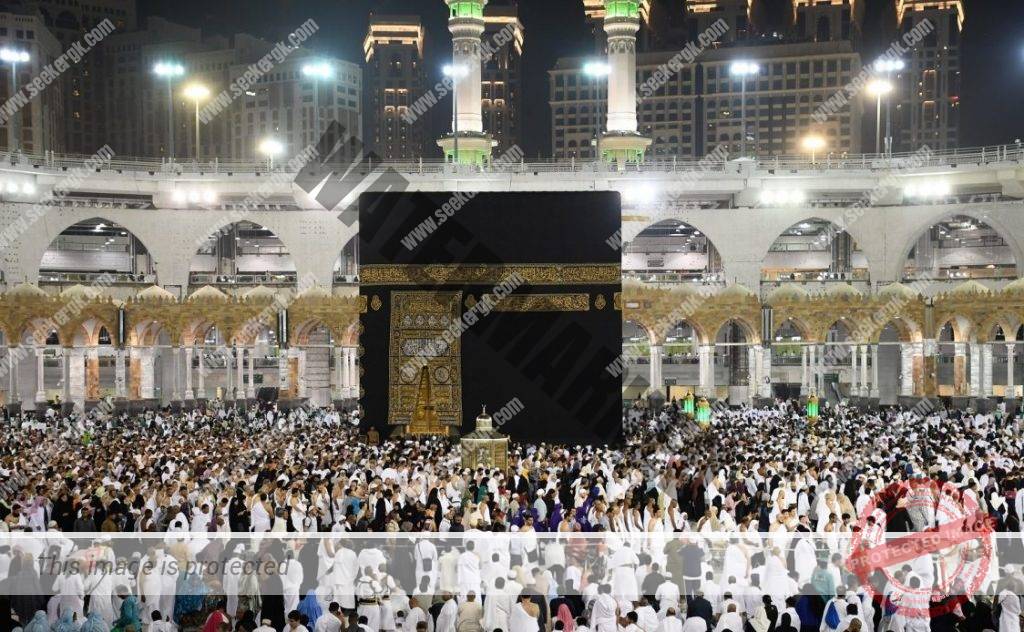Islamic Hajj General Knowledge

HAJJ is a journey to a sacred place called Kaaba of Saudi Arabia. Islamic Hajj is the annual pilgrimage, which all Muslims are required to undertake once in their lives, provided they have the financial means.
Hajj is one of the best acts of worship. It is one of the pillars of Islam with which ALLAH (SWT) sent Muhammad (SAW) and without which a person’s religious commitment is incomplete.
Worship cannot bring a person closer to ALLAH (SWT) and cannot be accepted unless it meets two conditions:
1 – Sincerity towards ALLAH (SWT) alone, i.e., it is done to seek the Countenance of Allaah and the Hereafter, and is not done to show off, to enhance one’s reputation or for worldly gain.
2 – Following the Prophet (peace and blessings of ALLAH (SWT)be upon him) in word and deed. Following the Prophet (peace and blessings of Allaah be upon him) can only be achieving by knowing his Sunnah.
Hence the one who wants to worship ALLAH (SWT) by doing any act of worship – Hajj or anything else – has to learn the teachings of the Prophet (peace and blessings of Allaah be upon him) concerning it, so that his actions will be in accordance with the Sunnah.
We will sum up in these few lines the description of Hajj as narrated in the Sunnah.
Types of Hajj
There are three types of Hajj:
- Tamattu
- Ifraad
- Qiraan.
Tamattu’ means entering ihraam for ‘Umrah only during the months of Hajj (the months of Hajj are Shawwaal, Dhu’l-Qi’dah and Dhu’l-Hijjah; see al-Sharh al-Mumti’, 7/62). When the pilgrim reaches Makkah he performs tawaaf and saa’i for ‘Umrah, and shaves his head or cuts his hair, and exits ihraam. Then when the day of al-Tarwiyah, which is the 8th of Dhu’l-Hijjah, comes, he enters ihraam for Hajj only, and does all the actions of Hajj. So Tamattu’ involves a complete ‘Umrah and a complete Hajj.
Ifraad means entering ihraam for Hajj only. When the pilgrim reaches Makkah he performs tawaaf al-qudoom (tawaaf of arrival) and saa’i for Hajj, but he does not shave or cut his hair and does not exit ihraam, rather he remains in ihraam until he exits ihraam after stoning Jamarat al-‘Aqabah on the day of Eid. If he delays the saa’i of Hajj until after the tawaaf of Hajj, there is nothing wrong with that.
Qiraan means entering ihraam for ‘Umrah and Hajj both together. Or entering ihraam for ‘Umrah first then including Hajj in that before starting the tawaaf of Hajj. That is done by intending that his tawaaf and saa’i will be for both Hajj and ‘Umrah.
The actions done in Qiraan are the same as those done in Ifraad, except that the pilgrim doing Qiraan has to offer a hadiy (sacrifice) whereas the pilgrim doing Ifraad does not.
The best of these three types of Hajj is Tamattu’. This is what the Prophet (peace and blessings of Allaah be upon him) enjoined upon his companions and urged them to do. Even if a person enters ihraam for Qiraan or Ifraad, then it is strongly recommended for him to change his intention to ‘Umrah, then complete ‘Umrah and exit ihraam, so that he will then be doing Tamattu’. He may do that after doing tawaaf al-qudoom and saa’i – because when the Prophet (peace and blessings of Allaah be upon him) did tawaaf and saa’i during his Farewell Pilgrimage, and his companions were with him, he told everyone who did not have a sacrificial animal (hadiy) to change his intention and make his ihraam for ‘Umrah and to cut his hair and exit ihraam, and he said, “Were it not that I have brought the hadiy with me, I would do what I have commanded you to do.”
Ihraam
The pilgrim should observe the Sunnahs of ihraam which are mentioned in the question referred to above, namely doing ghusl, applying perfume and praying. Then he should enter ihraam after he finishes the prayer or after boarding his means of transportation.
Then if he is doing Tamattu’, he should say, “Labbayk Allaahumma bi ‘Umrah (Here I am, O Allaah, for ‘Umrah).”
If he is doing Qiraam, he should say, “Labbayk Allaahumma bi Hijjah wa ‘Umrah (Here I am, O Allaah, for Hajj and ‘Umrah).”
If he is doing Ifraad, he should say, “Labbayk Allaahumma Hajjan (Here I am, O Allaah, for Hajj).”
Then he should say, “Allaahumma haadhihi hijjah laa riyaa’a fiha wa la sum’ah (O Allaah, this is a pilgrimage in which there is no showing off or seeking reputation).”
Then he should recite the Talbiyah as the Prophet (peace and blessings of Allaah be upon him) did: “Labbayka Allaahumma labbayk, labbayka laa shareeka laka labbayk. Inna al-hamd wa’l-ni’mata laka wa’l-mulk, laa shareeka lak (Here I am, O Allaah, here I am. Here I am, You have no partner, here I am. Verily all praise and blessings are Yours, and all sovereignty, You have no partner).”
The Talbiyah of the Prophet (peace and blessings of Allaah be upon him) also included the words, “Labbayka ilaah al-haqq (Here I am, O God of Truth).”
Ibn ‘Umar used to add to the Talbiyah the words, “Labbaayk wa sa’dayka, wa’l-khayr bi yadayka, wa’l-raghba’ ilayka wa’l-‘aml (Here I am and blessed by You, and all good is in Your hands, and desire and action are directed towards You).”
Men should raise their voices when saying this, but a woman should recite in such a manner that those who are beside her can hear it, unless there is a man beside her who is not one of her mahrams, in which case she should recite it silently.
If the person who is entering ihraam fears some obstacle that may prevent him from completing his pilgrimage (such as sickness, an enemy, being stopped from proceeding any further, etc), then he should stipulate a condition when entering ihraam by saying, “If I am prevented then my exiting ihraam is where I am prevented” – i.e., if something prevents me from completing my pilgrimage such as sickness or delay etc, then I will exit my ihraam. The Prophet (peace and blessings of Allaah be upon him) commanded Dubaa’ah bint al-Zubayr, when she wanted to enter ihraam but she was sick, to stipulate such a condition, and he said, “Your condition is valid with your Lord.” Narrated by al-Bukhaari (5089) and Muslim (1207).
If he stipulates this condition and something happens to prevent him from completing his pilgrimage, then he exits his ihraam and does not have to do anything (i.e., offer a sacrifice in compensation).
But the one who does not fear that some obstacle may prevent him from completing his pilgrimage does not have to stipulate any conditions, because the Prophet (peace and blessings of Allaah be upon him) did not stipulate conditions nor did he command everyone to do so. Rather he told Dubaa’ah bint al-Zubayr to do that because she was sick.
The muhrim (person who has entered ihraam) should recite the Talbiyah a great deal, especially when circumstances and times change, such as when going up to a high place or going down to a low place, or when night or day begin. After that he should ask Allaah for His good pleasure and for Paradise, and seek refuge in His Mercy from the Fire.
The Talbiyah is prescribed in ‘Umrah from the moment one enters ihraam until one starts Tawaaf. In Hajj it is prescribed from the moment one enters ihraam until one stones Jamarat al-‘Aqabah on the day of Eid.
In short, some important General knowledge of Islamic Hajj are as follow
Islamic Hajj(Pilgrim) General Knowledge |
|
| 1 | Hajj means to intend. |
| 2 | Hajj made compulsory in 9 A.H. |
| 3 | First Hajj offered in 9 A.H. |
| 4 | Hajj ordained in Surah Bakr. |
| 5 | The holy prophet performed only 1 Hajj in 10th A.H. |
| 6 | There are 3 types of Hajj. |
| 7 | One tawaf of Kaaba is known as Shoot. |
| 8 | Tawaf begins from Shoot. |
| 9 | Number of Jamarat is 3. |
| 10 | The mosque located in Mina is Kheef. |
| 11 | At Meekat, Hujjaj assume the state of Ihram. |
| 12 | Kalima Tauheed is recited during Hajj. |
| 13 | At Mina the ritual of offering sacrifice is performed |
| 14 | Jamart-throwing of pebbles, it is performed on 10th, 11th, 12th and 13th of Zul Hajj. |
| 15 | Maghrib and Isha both prayers are offered together at Muzdalifa on 9th Zil Hajj. |
| 16 | Yome-Afra is called to Hajj day. |
| 17 | Name of the place where the pilgrims go from Arafat: Muzdalfa. |
| 18 | First structure of Kaaba was built by Adam. |
| 19 | Ibrahim & Ismail rebuilt Kaaba 4500 years ago. |
| 20 | Yum-e-Nahar is called to the Day of Sacrifice. |
| 21 | Yum e Arafat is 9th Zul Hajj. |
| 22 | One khutba is only during Hajj. |
| 23 | Al-Imarn is the surah in which Hajj is commanded. |
| 24 | Holy prophet sacrificed 63 camels during hajj. |
| 25 | Adam and Hazrat Hawa performed the first ever Hajj. |
| 26 | Running b/w Safa & Marwa seven times is called Sayee. |
| 27 | Most important step of Hajj after assuming Ahram is Wuquf. |
| 28 | Waqoof-e-Arfah is the Rukn-e-Azam of Hajj |
| 29 | With the performance of Rami on the 10th Zil-Hajj, the most of the bindings of Hajj on the pilgrim are released. |
| 30 | Three upright stones are called Jamarat. |
| 31 | After Waquf the most important step is Tawaf. |
| 32 | In Hajj there are three obligations (Farz). |
| 33 | Umrah can be performed at any time throughout the year except 9th to 11th Zil-Hajj. |
| 34 | Hujjaj stat at Mina for one day, the second day at Arafat and the final day, encampment is done for a night at Muzdalfah, it is called Wuquf |
Islamic Hajj(Pilgrim) is obligatory on those only who have the required resources.








